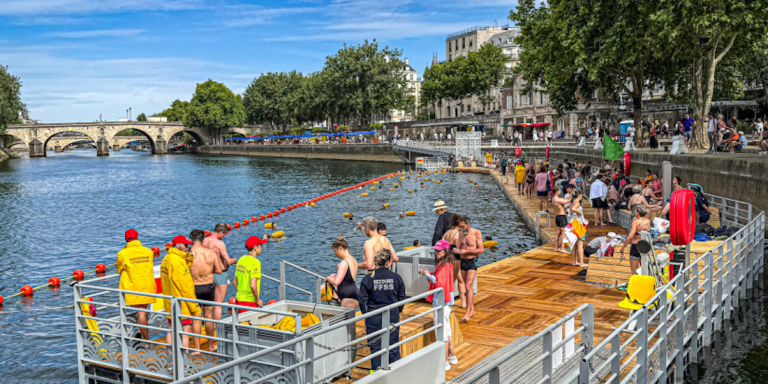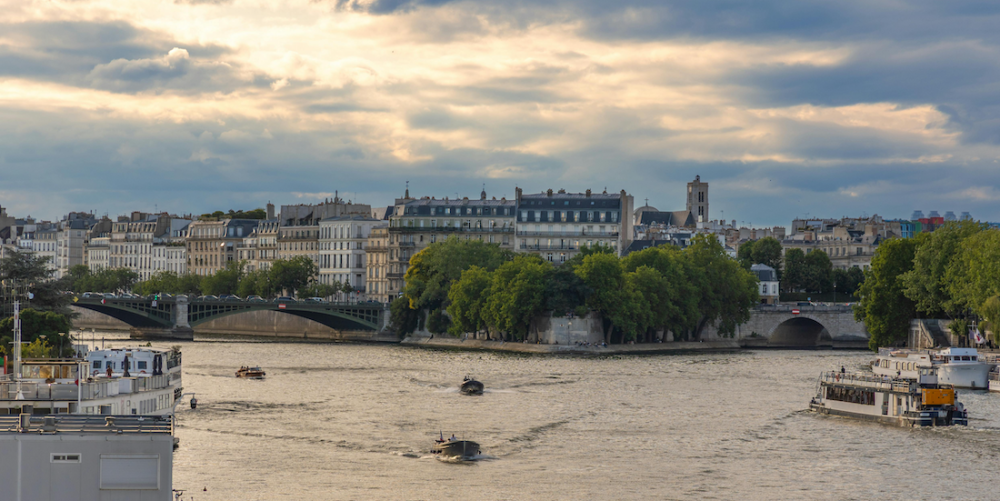
After 100 years, the City of Light officially reopens its iconic waterway for public swimming
New York, N.Y. – Cries of “It’s warm!” rang out across the Seine on Saturday morning as Parisians jumped into the river — legally — for the first time in more than 100 years. The momentous occasion marked the culmination of a decade-long environmental restoration project that transformed one of Europe’s most polluted urban waterways into a swimmable destination for residents and tourists alike.
Three sites along the banks of the Seine in the city will be able to welcome over 1,000 swimmers daily until August 31, local officials said, to the delight of the Parisians and visitors who were among the first to take the plunge. Bathing sites will be located near the French capital’s Notre-Dame cathedral, the Eiffel Tower and in eastern Paris.
The reopening represents a remarkable environmental achievement that few thought possible just a decade ago.
Swimming or bathing in the Seine has been banned since 1923 when the river
was deemed unsafe. The prohibition lasted over a century as the waterway became
increasingly polluted with industrial waste, untreated sewage, and urban runoff.
A Billion-Dollar Environmental Transformation
The path to Saturday’s historic plunge began with an ambitious vision tied to the 2024 Paris Olympics. The long-polluted waterway is finally opening up as a summertime swim spot following a 1.4 billion euro ($1.5 billion) cleanup project that made it suitable for Olympic events. They dug a giant reservoir to capture untreated sewage before it flows into the channel.
The massive infrastructure project involved constructing underground storage facilities capable of holding millions of gallons of stormwater and sewage during heavy rainfall events. Previously, these untreated waters would flow directly into the Seine, creating dangerous bacterial levels that made swimming impossible. Engineers also upgraded sewage treatment facilities throughout the Paris metropolitan area and implemented new monitoring systems to track water quality in real-time.
The transformation required unprecedented coordination between municipal authorities, environmental agencies, and construction teams. Workers labored for years to install new pumping stations, expand treatment capacity, and create the underground reservoirs that now prevent contaminated water from reaching the river during storms.
Olympic Legacy Becomes Public Treasure
What began as an Olympic necessity has evolved into a lasting gift to Parisians. The successful hosting of swimming events during the 2024 Summer Olympics demonstrated the river’s newfound cleanliness and safety. Officials conducted extensive water quality testing throughout the Games, with results consistently meeting international standards for recreational swimming.
The Olympic legacy infrastructure now serves the broader community. Making the Seine swimmable is first and foremost a response to the objective of adapting to climate change, but also of quality of life. As urban temperatures rise and traditional cooling methods prove insufficient, access to clean swimming water becomes increasingly valuable for public health and well-being.
City planners designed the swimming areas with long-term use in mind. Two newly built wooden decks near the Eiffel Tower provide safe entry and exit points, while designated swimming zones ensure boats and swimmers can coexist safely on the busy waterway.
Environmental Milestone for Urban Rivers
The Seine’s transformation represents a significant victory for urban environmental restoration efforts worldwide. Major cities from London to New York have struggled with similar challenges of cleaning polluted waterways that were once vital recreational resources. Paris’s success provides a roadmap for other municipalities seeking to reclaim their rivers for public use.
The project’s environmental benefits extend beyond swimming. Improved water quality supports aquatic wildlife, with fish populations showing marked improvement since the cleanup began. The enhanced water treatment infrastructure also protects downstream communities and reduces pollution flowing into the English Channel.
Environmental scientists note that the Seine’s restoration required addressing pollution at its source rather than simply treating symptoms. The comprehensive approach included upgrading industrial discharge standards, improving agricultural runoff management, and implementing stricter regulations on urban development near waterways.

A New Chapter for the City of Light
Saturday’s swimmers experienced more than just a refreshing dip—they participated in a historic moment that reconnects Paris with its maritime heritage. “Really nice, I’m impressed, surprised,” said one early swimmer, capturing the amazement many felt at the river’s transformation.
The swimming program operates during daylight hours with lifeguards present and regular water quality monitoring. Officials emphasize that the designated areas represent the safest zones for swimming, with ongoing efforts to expand access as water quality continues to improve.
This historic reopening signals a new relationship between Parisians and their river
After more than a century of separation, the Seine once again serves as a source of recreation, cooling, and community gathering. The success of this monumental cleanup project demonstrates that even the most polluted urban waterways can be restored with sufficient commitment, investment, and innovative engineering.
As summer continues, the sight of swimmers enjoying the Seine will serve as a daily reminder of what environmental restoration can achieve when communities commit to ambitious goals and long-term thinking.
Audio Summary
After a century-long ban, Parisians can legally swim in the Seine River following a $1.5 billion cleanup project originally designed for the 2024 Olympics. Three designated swimming areas near major landmarks welcome over 1,000 daily swimmers, marking a historic environmental victory that transforms one of Europe’s most polluted urban waterways into a recreational treasure for residents and visitors.
#ParisSwimming #SeineRiver #EnvironmentalRestoration #Paris2024Olympics #UrbanRenewal #CleanWater
#SustainableCities #EnvironmentalSuccess #WaterQuality #UrbanSwimming #ParisLife #ClimateAdaptation
TAGS: Paris, Seine River, swimming, Olympics, environmental restoration, water quality,
urban planning, pollution cleanup, recreational swimming, climate change adaptation, urban waterways,
public health, infrastructure investment, environmental engineering, sustainable cities
